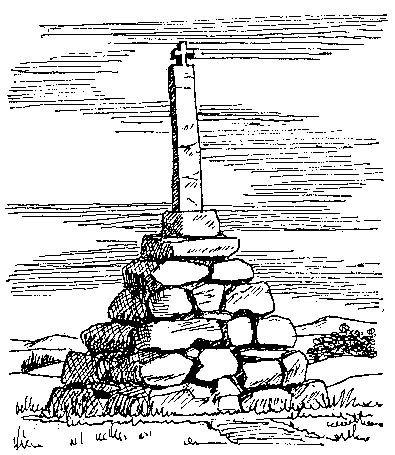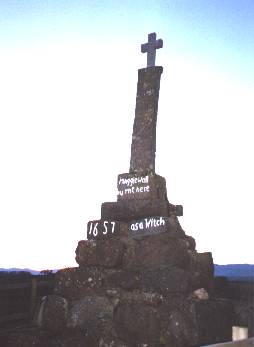

THE MYSTERY OF THE WITCH'S GRAVE
This speculative piece about Dunning's most famous monument was written by freelance writer Steve McGrail and originally appeared in 'The Highlander' magazine, U.S.A., August, 1995
The old stone cross rises up, almost twenty feet high. It stands beside the road, the land behind it slipping sharply down to rolling fields. Looking at it from a distance, a visitor stranger used to Scotland might guess that it is some sort of battle memorial. Right enough, Sheriffmuir is not too far away, the nearby village of Dunning was burned by the Jacobites in 1716 and the ancient battlefield of Duncrub is close by. But the cross marks none of those.Something to do with the Covenanters, then? Again no, even though this part of Perthshire was once a hotbed of religious fervour. What, then? Seen close up, the monument quickly tells its story. Roughly painted on the stones are the chilling words 'Maggie Wall burnt here 1657 as a Witch' There is no official plaque from Historic Scotland or the National Trust. Somehow, they make it all the more moving for this is a place of sadness where a dreadful thing happened hundreds of years ago. In the name of....well, in the name of what? A woman was burned at the stake here. If she were lucky she was strangled first. If not, then she died in agony on a pyre of heat and coal doused with tar, perhaps still crying her innocence as the flames around her roared and spat. People who see the cross shudder. Some have felt the tears coming. It is a sad place indeed.
But it is a place of many mysteries too. For a start who was Maggie Wall? And when over 4,000 women were executed in Scotland for witchcraft in the sixteenth and seventeenth centuries, why commemorate her alone? It is not because, as the Perthshire tourist map says, she was the last to be burned at the stake. She was not. There were many more.

The questions come thick and fast, but not the answers. Maybe this is inevitable when so little is known about her. There are local stories, of course. It is said that the site of her cottage has even been found. Was she old, was she young? Was she an outsider, perhaps? 'Wall' is a name from Orkney, a corruption of Wallace, or from the Borders. It is common in Ireland too. But her name does not appear in the records at all, which is odd. Witch trials were often carefully recorded. Diligent clerks even put down grim details such as the cost of the peat used for the fire and the rope needed by the executioner. But there is nothing mentioned about poor Maggie. A hundred years ago, Dunning's minister actually claimed that the story was a hoax, why build a monument using such huge boulders and square cut stones? Perhaps Dr. Wilson was just plain embarrassed about what one of his predecessors must have been involved in so he decided Maggie was a myth. Someone still seems to think that the Church had blood on its hands, however. Historican Archie McKerracher in his book on Perthshire says that a wreath is left at the cairn each year, with a card saying 'In memory of Maggie Wall, Burnt by the Church in the Name of Christianity'.
Sketch by Kenny Laing
Nobody knows what her 'crime' was. Perhaps somebody's cow took sick and died and Maggie got the blame. Maybe she just knew too much for her own good about the special properties of herbs and flowers. There again, perhaps the 'Witch Pricker' was called in to look for the 'Devil's Mark' on her body, and found it. This was a patch of skin stained red, brown or blue where his three-inch blade gave no pain when he pushed it in.
The truth is blacker. Probably it has more to do with politics than spells, for Maggie Wall lived and died in troubled times. She also had the bad luck to live in an area with a terrible reputation for persecuting witches. Six more were executed in Dunning in 1663, in a wood on the other side of the village. That number is terrifying for a village of perhaps a few hundred souls. Fear and hysteria were in the air and no woman was safe.
Oliver Cromwell who was governing the country when she died had actually tried to rein back the burnings. For some reason, however, there was an outbreak in 1657 and 1658. Things calmed down but flared up again when Charles II took over in 1660. The persecution was savage. It began to seem as if certain people were making up for lost time. Maggie Wall was one more victim. But why her? It could be that her death had something to do with an event that had happened in Dunning just five years before.
Scotland was torn apart by religious passions, fiery and furious debates. People came to blows and often died for their beliefs. Some preachers were treated like stars, the crowds hanging on their every word as they called down hellfire on their rivals, or cast out devils, or denounced adulterers and lechers. It seems that Dunning had one of these, the Rev.George Muschet.
Local people might have admired their minister's preaching, but the Church authorities in Perth did not. He was upsetting their ideas of God's truth and they tried to stop him. They argued with him, they threatened him, but he ignored them. So, in 1652, a group from the Presbytery of Perth set out for Dunning to hold a Synod to discipline him. The Reverend was going to be sorted out once and for all.
They never made it. A crowd of 120 women led by the wife of the minister of Auchterarder (who was also in trouble) met the group as they tried to get into the Dunning church, St. Serf's. They set on them and attacked them with sticks. To the women, George Muschet was their pastor and that was how it was going to stay! In the riot, the brethren lost their horses, their cloaks were ripped off their backs, the Synod Clerk was held hostage and beaten 'until he foreswore his office'. Bruised and battered, they fled in disarray. Four miles outside the village they regrouped, seething with rage. There they made solemn pronouncement that 'this village should never more have a Synod kept in it but be accursed; and that although in the years 1638 and 1639 the godly women were called up for stoning the bishops, yet now the whole sex should be esteemed wicked'.
Was it this pronouncement that sealed Maggie Wall's fate? had she herself been involved in the disturbances as a leader? But now, the village was 'accursed', her sex 'wicked'. Did she become a scapegoat for what had happened, was her death someone's frightful revenge for the humiliation that was suffered? Did someone plot and brood, was a neighbour's chance remark or spiteful accusation the spark needed to light the final ghastly inferno? It is very tempting to think so.
But the trail quickly goes cold. Nothing in writing links the riot to the burning. Reverend Muschet was finally deposed and replaced by the third son of Lord Andrew Rollo, the local landowner. If that were just a coincidence, it must surely have suited somebody nicely. The former minister carried on preaching, however. When he died in 1663, his will described him very firmly as 'Preacher of God's Word'. He must still have had influence locally, at least. As he lay dying, did he think about Maggie Wall, did he see himself as at all responsible? We will never know the answer.
There is another puzzle. In the same year that Maggie died, a warlock lived in Dunning. He was described as 'Johnnie Gothrie, charmer'. As with the Reverend Muschet, the Presbytery of Perth came to try his case. He was banned from taking the Sacrament and local people were warned not to talk to him. He survived, while Maggie Wall died. Why? True enough, not many warlocks were killed as compared with witches. Even so, he was lucky. Perhaps he had influential supporters. A local story hints that she might have had one friend or at least someone who had once been an enemy but who had changed his mind, too late to save her.
This story concerns the cairn itself. There is no other memorial like it in Scotland to a witch. Only a very powerful person could have risked building it, while putting a Christian symbol on top of it was like defying the Church. Ordinary folk would not usually dare to show sympathy to a witch, dead or alive. Who knew where the accusing finger would point next? Local historian Kenny Laing thinks that it was Lord Rollo himself who ordered the monument to be built, on his estate where the burning took place. As a landowner he would have sat in judgment over Maggie. Along with others he would have signed the documents and he would have heard the minister, his own son Andrew, utter the fatal words sentencing her to death. In his bitter shame, thinks Kenny, Lord Andrew had the memorial built soon after the execution. A local legend says it was done when Lady Rollo was away, as she disapproved of the scheme. Again, there is the whiff of local politics and hints of strife among the aristocracy themselves over the affair.
Whatever the truth of this, there stands Maggie Wall's memorial to this day. But it does not give up its secrets easily. It has another. Who paints the inscription on the stones?

People in the area say they genuinely do not know, but they have their suspicions. Whoever does it, does it regularly. The tradition seems to go back a long way. A photograph taken perhaps a hundred years ago shows the lettering already there, just as it is now. The modern artist simply follows the original outlines. But why? Is the task handed down in some local family? Is it done by the same person who lays the wreath? And above all, why does a poor woman who died so long ago matter so much to someone today?
Because matter she surely does, and to many people. Perhaps more come to her grave than come to see Dunning's other well-known monument, the 12th century church of St. Serf's. Among visitors in the past have been the infamous 'Moors Murderers' Ian Brady and Myra Hindley. A photograph of their holiday in Scotland clearly shows them at the cairn. As visitors, they are fortunately an exception, although of course a few people bring ghoulish fantasies. Locals are pretty matter of fact about the whole business of the grave. Says Kenny Laing 'We used to play near the cairn when I was a youngster; it never bothered us. There were trees around it then, Maggie Wall's Wood it was called. We weren't scared or anything like that. Ghost stories? No, I've never heard any about Maggie Wall'.
People visit the site for all sorts of reasons. Scotland's dark and bloody history fascinates some. Perhaps others come to pity, bringing flowers bought from a shop, or taken from the hedgerows. Some try to understand the superstitiions of the past. Many simply wonder at human cruelty. But whatever they think about what happened here, the witch's grave keeps its mysteries.
Steve McGrail, Dunblane, 1995
Editor's note: The last woman burnt as a witch in Scotland was Janet Horne, in Dornoch in 1722.